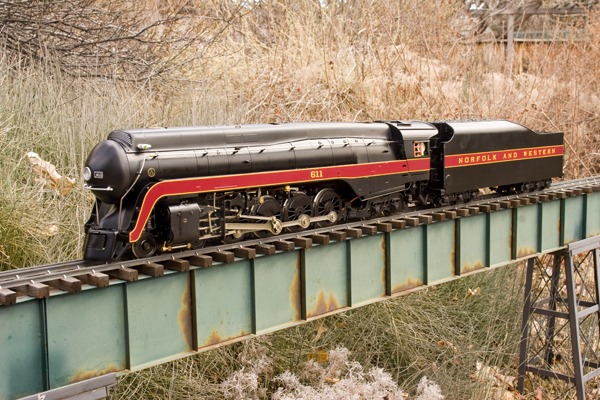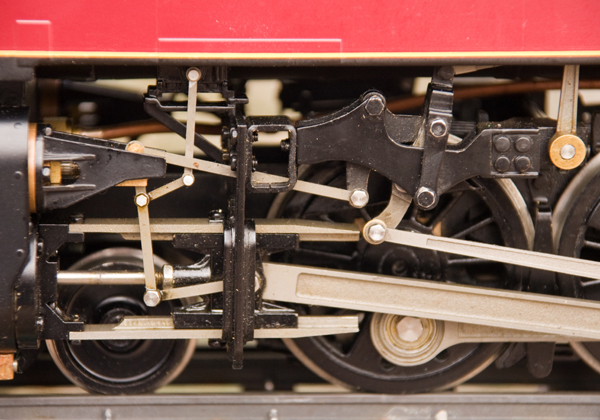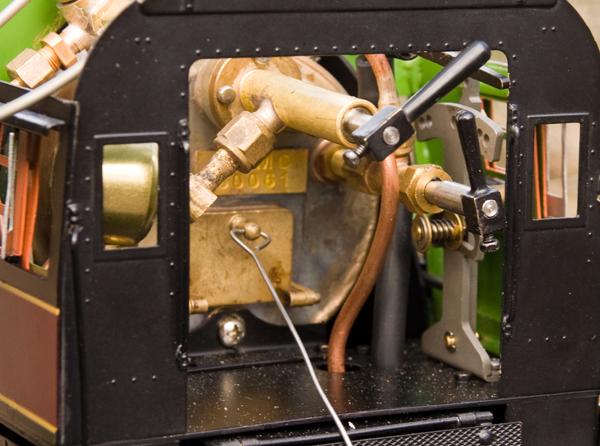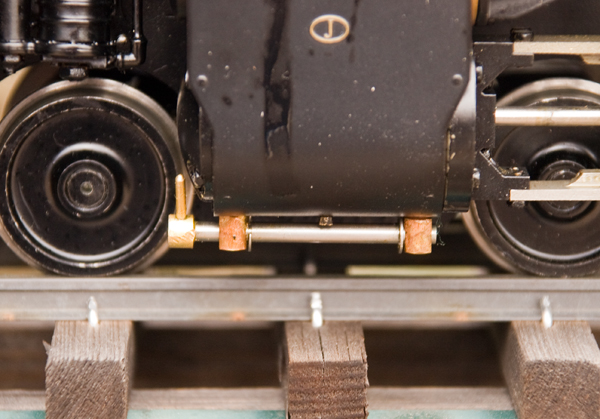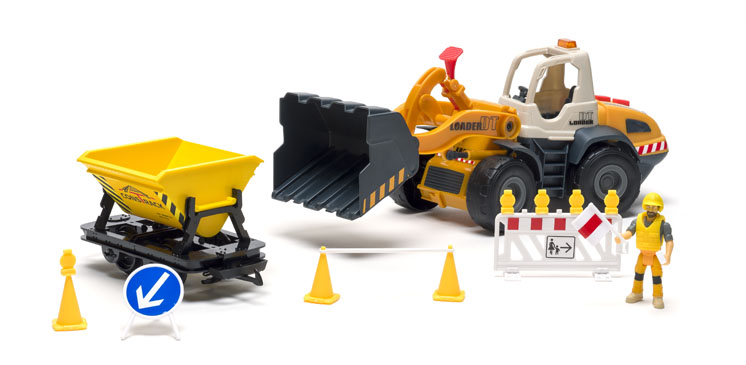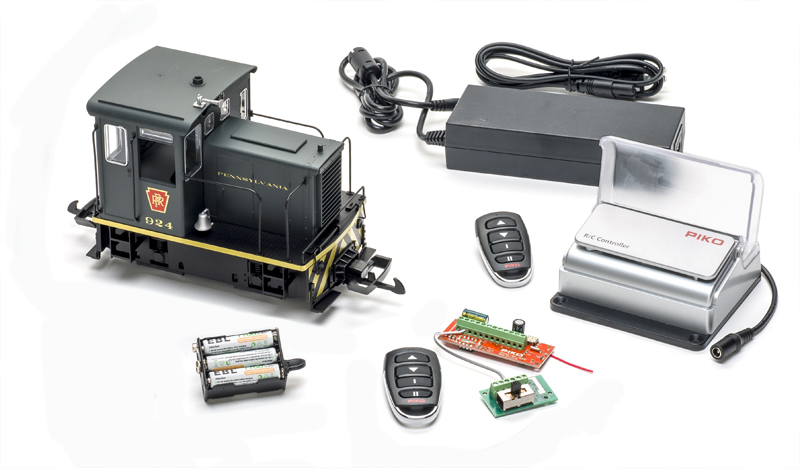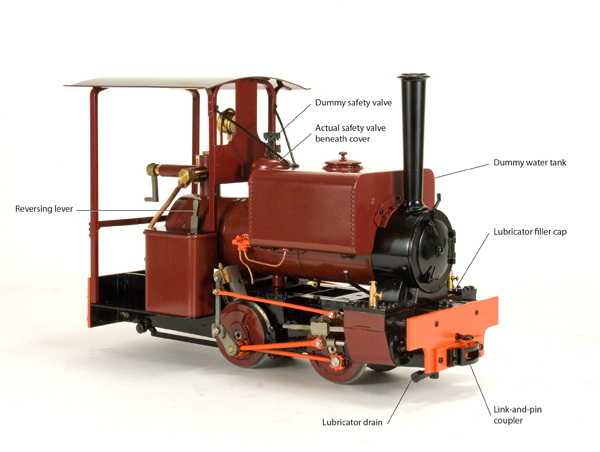Accucraft Trains
33268 Central Ave.
Union City CA 94587
Price: $5,950
Website: www.accucraft.com
All metal, 1:32 scale, gauge-1 model of Norfolk & Western J-class streamlined 4-8-4; working Baker valve gear controlled from the cab; gas-fired boiler; ceramic burner; weight, 28.8 pounds (loco, 19.8 pounds; tender, 9 pounds); fittings: two safety valves, axle pump driven from second axle, hand pump in tender, throttle, blower valve, pressure gauge, water glass, bypass valve, whistle, displacement lubricator, cylinder drain cocks; sprung driving axles; sprung six-wheel tender trucks; ; 10′ minimum radius. Dimensions: length, 42″ (locomotive and tender); width, 4.25″; height, 7 in. In 1:32 scale this works out to 112’0″ x 11’4″ x 18’8″, respectively
Pros: Beautiful, well made engine; correct scale/gauge combination; fully fitted boiler; excellent paint and graphics; high level of detail; excellent running characteristics
Cons: Fire door a little too stiff to conveniently open with supplied rod; no lubricator drain; no filler plug; no blowdown valve; unprototypical whistle
Accucraft’s model arrived in a big box weighing 65 pounds. Unpacking an Accucraft locomotive is a job in itself, especially a large one like this. You should allow yourself at least an hour just for unpacking. The locomotive and tender, wrapped in tissue and plastic, are each packed in their own wooden boxes. They are firmly secured to wooden platforms with strapping tape and foam inserts. The platforms are bolted into the boxes. There is a separate compartment in the tender’s box that holds the usual accessories: pump handle, syringes, wrenches, etc.
Once I got the locomotive and tender unpacked, I had a good look at them. My first thought was, “Impressive!” Accucraft has produced another fine model, an accurate representation of its prototype. The engine has all drivers sprung and a high level of detail. Its Baker valve gear is controlled from a reversing lever in the cab. Water can be fed to the boiler via a hand pump in the tender tank. This is plumbed in series with the axle pump. When the engine is moving, the axle pump, driven by an eccentric on the second axle, can be used to keep the boiler topped up. A bypass valve on the back of the cab, below the footplate, returns unneeded water to the tender tank.
Boiler fittings include a pressure gauge, water glass, throttle, blower valve, whistle valve, and two safety valves. Access to controls is via Accucraft’s standard hinged cab roof. The locomotive is fired with butane gas. (An alcohol-fired version is also available.) A large gas tank resides in the tender under the dummy coal load, which must be removed for filling. Once the tank has been filled, the coal can be replaced. A valve handle protrudes unobtrusively through the coal load to control the gas. The whole tender shell forms the water tank as well as a water bath for the gas tank to keep it from freezing. A removable panel at the rear gives access to the hand pump.
The locomotive is fitted with a ceramic burner that is lit through the fire door. This fire door has a long, thin rod attached to it. The hinges on our review sample were a little too stiff, making it difficult to easily open and close the door with this rod.
Under the left-hand running board is a good-sized displacement lubricator. Beneath the right-hand running board is the whistle. This is just a single-chime affair and is completely incapable of producing the deep, throaty, multi-chime sound that the prototype makes. The whistle, in my opinion, does nothing to enhance this elegant locomotive and might just as well have been left off.
Each driving axle is sprung. All drivers are flanged and, given the long wheelbase, a 10′ minimum radius is recommended—more is better. The prototype locomotive itself was fairly rigid and had trouble with raggedy track. I suspect the model behaves prototypically in this regard. There is a front coupler that hides behind a swinging door, which preserves the locomotive’s streamlined aspect. The door on our review sample did not fit well and was prone to opening a little.
There are three hoses between the locomotive and tender: two for the feedwater system and one for gas to the burner. Transporting the engine and tender should be done individually because of their length and weight. They can be connected when on the track.
The weather on test-run day was a mild 75 degrees, with a breeze. I prepared the engine on the bench, oiling all moving parts with a lightweight machine oil, then filling the displacement lubricator with steam oil. I filled the gas tank in the tender with butane and the surrounding tank with distilled water. With the engine and tender on the track, I connected the various water and fuel lines. The gas line and water-return line are push fits, while the feedwater line has a screw connector.
I used the hand pump in the tender to fill the boiler. The boiler on the engine is huge, and it took a long time. There is no filler plug on the boiler itself for initial charging, so you just have to sit there and pump. Once the boiler is full, keeping it that way is no trouble, either with the hand pump or, while the engine is running, with the axle pump.
Unlike most gas-fired engines, this one is equipped with a blower, controlled by a valve in the cab. This is similar to coal- and alcohol-fired engines with internally-fired boilers, so you’ll need a suction fan (not included) to get this locomotive going. Also unlike most gas-fired engines, this one is lit through the fire door on the boiler’s backhead. You’ll need something like a long-nose barbecue lighter to get into the firebox. I placed the fan in the smoke stack and turned it on. I used the igniter I normally use for alcohol-fired engines—a bit of wicking on the end of a wire—to light the fire. I soaked this in alcohol and lit it, then turned on the gas a little. I poked the flame into the firebox and the fire lit immediately.
The rectangular ceramic burner pretty well fills the firebox. Initially, the fire appears as myriad points of blue flame. When the burner warms up, it glows orange. Because of the stiff firebox-door hinges, I had to poke the door closed with a screwdriver.
It took about 10 minutes to heat that huge boiler to 20 psi, at which point I removed the suction fan and turned on the engine’s blower. When pressure was up to 50 psi, I opened the cylinder drain cocks, put the engine into forward gear, and opened the throttle. It took a little bit of pushing before the engine showed signs of life.
Water spurted from both of the drain cocks and the stack. The condensate soon cleared and the engine was off and running.
I found the throttle to be a little touchy when the engine was running light. After some experimentation, though, I found a setting that it seemed to like. I think its performance would improve with a heavy train behind it, which would smooth things out some while allowing the engine to be run at a higher throttle setting.
The minimum recommended radius is 10 feet. I think this engine would find that pretty tight. Even my 13-foot-radius track slowed it down on curves. Since all drivers are flanged, there’s bound to be a little flange binding on all but the broadest curves. Having said that, though, the engine performed well.
The roof swings to the side for access to the cab. With a little practice, the throttle lever can be accessed without lifting the roof. The pressure gauge is visible through a window but you’ll have to lift the roof to see the water glass and get to the reversing lever.
This locomotive is magnificent in motion. It exudes power in the same way as its prototype. It’s a smooth runner, even running light, due in part to its weight. Its big cylinders will probably pull just about anything you care to hang behind it. I’ve seen a video of it effortlessly pulling a nine-coach train. The whistle, as mentioned above, is a bit of a joke. It emits a clear, high tone, more suited to a British narrow-gauge locomotive. I didn’t time the run, shutting the engine down after about 45 minutes. I have heard reports of non-stop runs of an hour or more. You’ll have to stop to refuel, as the pumps will keep the boiler full.
To shut this engine down, I turned off the gas, closed the throttle, and opened the blower valve to relieve the pressure and prevent a vacuum from forming inside the locomotive when the boiler cooled. I would like to have had a blowdown valve to be able to properly blow down and drain the boiler.
To refill the displacement lubricator, the water must be sucked out with a syringe. Again, a drain valve on it would have been good. The only other little niggle is the size of the tender tank. It would be nice if there were a couple of baffles in there to mitigate sloshing, but this is a small matter.
My first impression of this engine was handsomely borne out. It is impressive indeed, whether running or sitting stationary. It’s not an engine I’d recommend to beginners but if you have some steam experience, you’ll enjoy this one. Spending time with it will reap dividends, too, as you discover its quirks and foibles and learn how to get the best possible run out of it given the conditions on your railroad.





